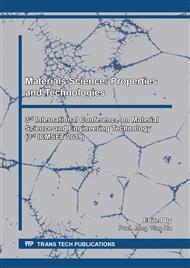p.47
p.55
p.63
p.69
p.73
p.79
p.85
p.91
p.97
Molecular Dynamics Simulation on Aqueous Solution of Calcium Carbonate System
Abstract:
Molecular dynamics simulation was used to investigate two models of aqueous solution ofcalcium carbonate system between 283K and 373K. The diffusion coefficients of water moleculesdemonstrated that both the electropositive surface (110) on Model-I and neutral surface (104) onModel-II showed interaction with the water molecules, and the surface (110) exhibited strongerelectrostatic interaction with water molecules than the latter, besides obvious anomaly appeared near343K on Model-I. On the other hand, surface (110) exhibited anomalous influences on Ca2+ andCO32- ions near 313K and 343K on Model-I, and only a broad anomaly on CO32- ions near 343K onModel-II. The binding energies between surface (110) / (104) and Ca2+ /CO32- ions demonstrated thatthe surface (104)were more favorable for the growth of the new crystal but weak for the diffusion.
Info:
Periodical:
Pages:
73-78
Citation:
Online since:
August 2019
Authors:
Price:
Сopyright:
© 2019 Trans Tech Publications Ltd. All Rights Reserved
Share:
Citation:


